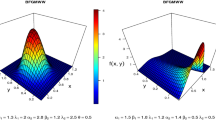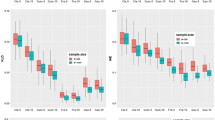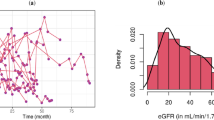Abstract
The purpose of this paper is to create a new bivariate model with more efficiency than the traditional models which discuss the effect of serum creatinine given the duration of diabetes. Based on FGM copula function and Chen distribution, we will introduce the bivariate FGM Chen distribution. Marginal distributions, product moments, and moment generating functions are studied as some of their statistical properties. Some dependency tests, such as Kendall’s tau, Pearson’s correlation, and regression model, are discussed. To estimate the model parameters, maximum likelihood and Bayesian estimation are used. In addition, for the parameter model, asymptotic confidence intervals and credible intervals of the highest posterior density for the Bayesian are calculated. A Monte Carlo simulation analysis is carried out of the maximum likelihood and Bayesian estimators.





Similar content being viewed by others
References
Flores AQ (2009) Testing Copula functions as a method to derive bivariate weibull distributions. APSA 2009 Toronto meeting paper. Available at SSRN: https://ssrn.com/abstract=1450064
Verrill SP, Evans JW, Kretschmann DE, Hatfield CA (2015) Asymptotically efficient estimation of a bivariate Gaussian–Weibull distribution and an introduction to the associated pseudo-truncated Weibull. Commun Stat Theory Methods 44(14):2957–2975
El-Sherpieny ES, Almetwally EM (2019) Bivariate generalized rayleigh distribution based on Clayton Copula. In: Proceedings of the annual conference on statistics (54rd), Computer Science and Operation Research, Faculty of Graduate Studies for Statistical Research, Cairo University, (pp 1–19
Almetwally EM, Muhammed HZ (2020) On a bivariate Fréchet distribution. J Stat Appl Probab 9(1):1–21
Almetwally EM, Muhammed HZ, El-Sherpieny ESA (2020) Bivariate Weibull distribution: properties and different methods of estimation. Ann Data Sci 7(1):163–193
Samanthi RGM, Sepanski J (2020) On bivariate Kumaraswamy-distorted copulas. Commun Stat Theory Methods. https://doi.org/10.1080/03610926.2020.1777303
Muhammed HZ (2016) Bivariate inverse Weibull distribution. J Stat Comput Simul 86(12):2335–2345
El-Morshedy M, Alhussain ZA, Atta D, Almetwally EM, Eliwa MS (2020) Bivariate Burr X generator of distributions: properties and estimation methods with applications to complete and type-II censored samples. Mathematics 8(2):1–31
El-Gohary A, El-Morshedy M (2016) Bivariate exponentiated modified Weibull extension. J Stat Appl Probab 5(1):67–78
Eliwa MS, El-Morshedy M (2020) Bivariate odd Weibull-G family of distributions: properties, Bayesian and non-Bayesian estimation with bootstrap confidence intervals and application. J Taibah Univ Sci 14(1):331–345
Muhammed HZ (2020) On a bivariate generalized inverted Kumaraswamy distribution. Physica A 553:124281
Alotaibi RM, Rezk HR, Ghosh I, Dey S (2021) Bivariate exponentiated half logistic distribution: properties and application. Commun Stat Theory Methods 50(24):6099–6121
El-Sherpieny ESA, Muhammed HZ, Almetwally EM (2022) Bivariate Weibull-G family based on copula function: properties, Bayesian and non-Bayesian estimation and applications. Stat Optim Inf Comput. 10(3):678–709. https://doi.org/10.19139/soic-2310-5070-1129
El-Sherpieny ESA, Almetwally EM, Muhammed HZ (2021) Bayesian and non-bayesian estimation for the parameter of bivariate generalized Rayleigh distribution based on clayton copula under progressive type-II censoring with random removal. Sankhya A. https://doi.org/10.1007/s13171-021-00254-3
Nelsen RB (2007) An introduction to copulas. Springer
Sklar A (1973) Random variables, joint distribution functions, and copulas. Kybernetika 9(6):449–460
Gumbel EJ (1960) Bivariate exponential distributions. J Am Stat Assoc 55(292):698–707
Almetwally EM (2019) Parameter estimation of bivariate models under some censoring schemes. Cairo University, Giza
Chen Z (2000) A new two-parameter lifetime distribution with bathtub shape or increasing failure rate function. Stat Probab Lett 49(2):155–161
Almarashi AM, Elgarhy M, Jamal F, Chesneau C (2020) The exponentiated truncated inverse Weibull-generated family of distributions with applications. Symmetry 12(4):650
Eghwerido JT, Ikwuoche JD, Adubisi OD (2020) Inverse odd Weibull generated family of distribution. Pak J Stat Oper Res 16(3):617–633
Elgarhy M (2019) On the exponentiated Weibull Rayleigh distribution. Gazi Univ J Sci 32(3):1060–1081
Muhammed HZ, El-Sherpieny ESA, Almetwally EM (2021) Dependency measures for new bivariate models based on Copula function. Inf Sci Lett 10(3):511–526
Fredricks GA, Nelsen RB (2007) On the relationship between Spearman’s rho and Kendall’s tau for pairs of continuous random variables. J Stat Plann Inference 137(7):2143–2150
Sungur EA (2005) Some observations on copula regression functions. Commun Stat Theory Methods 34(9–10):1967–1978
Hyun S, Lee J, Kim JM, Jun C (2019) What coins lead in the cryptocurrency market: using Copula and neural networks models. J Risk Financ Manag 12(3):132
Suzuki AK, Louzada-Neto F, Cancho VG, Barriga GD (2011) The FGM bivariate lifetime copula model: a bayesian approach. Adv Appl Stat 21(1):55–76
Louzada F, Suzuki AK, Cancho VG (2013) The FGM long-term bivariate survival copula model: modeling, Bayesian estimation, and case influence diagnostics. Commun Stat Theory Methods 42(4):673–691
Chen MH, Shao QM (1999) Monte Carlo estimation of Bayesian credible and HPD intervals. J Comput Graph Stat 8(1):69–92
Zimmerman DL (1993) A bivariate Cramér-von Mises type of test for spatial randomness. J Roy Stat Soc Ser C (Appl Stat) 42(1):43–54
Justel A, Peña D, Zamar R (1997) A multivariate Kolmogorov–Smirnov test of goodness of fit. Stat Probab Lett 35(3):251–259
Genest C, Huang W, Dufour JM (2013) A regularized goodness-of-fit test for copulas. Journal de la Société françSaise de statistique 154(1):64–77
Langrené N, Warin X (2021) Fast multivariate empirical cumulative distribution function with connection to kernel density estimation. Comput Stat Data Anal 162:107267
Genest C, Quessy JF, Rémillard B (2006) Goodness-of-fit procedures for copula models based on the probability integral transformation. Scand J Stat 33(2):337–366
Grover G, Sabharwal A, Mittal J (2014) Application of multivariate and bivariate normal distributions to estimate duration of diabetes. Int J Stat Appl 4(1):46–57
Kotz S, Balakrishnan N, Johnson NL (2004) Continuous multivariate distributions. Models and applications, vol 1. Wiley
Abd Elaal MK, Jarwan RS (2017) Inference of bivariate generalized exponential distribution based on copula functions. Appl Math Sci 11(24):1155–1186
Acknowledgements
The authors wish to thank the editor. We also thank anonymous for their encouragement and support. The authors are grateful to anyone who reviewed the paper carefully and for their helpful comments that improve this paper.
Author information
Authors and Affiliations
Corresponding author
Additional information
Publisher's Note
Springer Nature remains neutral with regard to jurisdictional claims in published maps and institutional affiliations.
Rights and permissions
About this article
Cite this article
El-Sherpieny, ES.A., Muhammed, H.Z. & Almetwally, E.M. Bivariate Chen Distribution Based on Copula Function: Properties and Application of Diabetic Nephropathy. J Stat Theory Pract 16, 54 (2022). https://doi.org/10.1007/s42519-022-00275-7
Accepted:
Published:
DOI: https://doi.org/10.1007/s42519-022-00275-7




